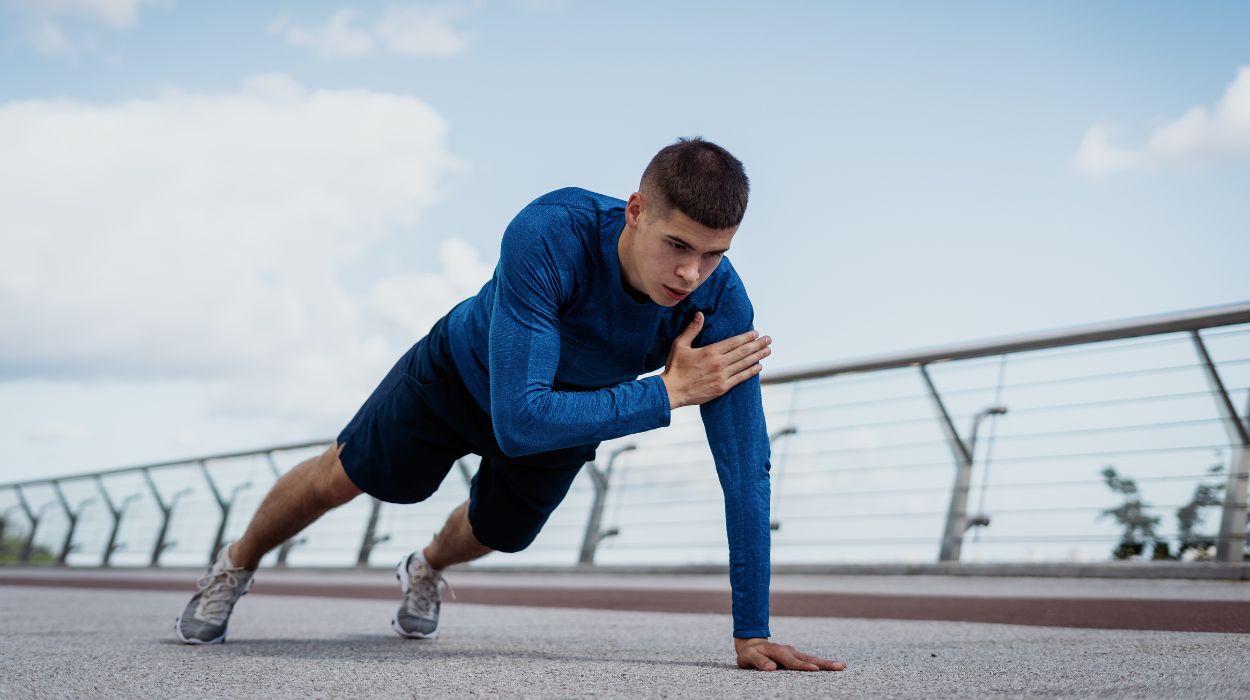
With an endless to-do list and long work hours, many people find it hard to exercise. If this resonates with you, don’t worry. Bodyweight workouts are a form of resistance training that doesn’t require weights or other gym equipment.
Among some of these exercises, bodyweight shoulder exercises are great additions you can make to your next workout. We’ve put together seven of the best shoulder exercises without weights with easy-to-follow steps. We also share the benefits and why these workouts can help you lead a healthier, more active lifestyle.
Bodyweight Shoulder Workouts For Everyone
Seven Bodyweight Shoulder Exercises:
7 Best Bodyweight Shoulder Exercises 2024
If you prefer to work out without weights, there are limitless bodyweight exercises to try. Bodyweight exercises can also be performed in the comfort of your home – a great option if you’re crunched on time.
No longer do you need to drive to a class or gym to get the benefits of physical activity. All you need is a mat and some motivation to get started. Whether you’re a beginner or regularly workout, bodyweight exercises offer a fun and challenging workout for everyone.
We’ve compiled a list of seven shoulder workouts without weights you can try for yourself as soon as today. Each exercise includes easy-to-follow steps, so you are guaranteed to get the most out of your next workout.
Shoulder Taps
This exercise is a great way to get your shoulder muscles burning using only your body weight. As the name implies, it involves tapping one shoulder and the other while holding yourself in a plank position. Follow the steps below to perform this exercise correctly.
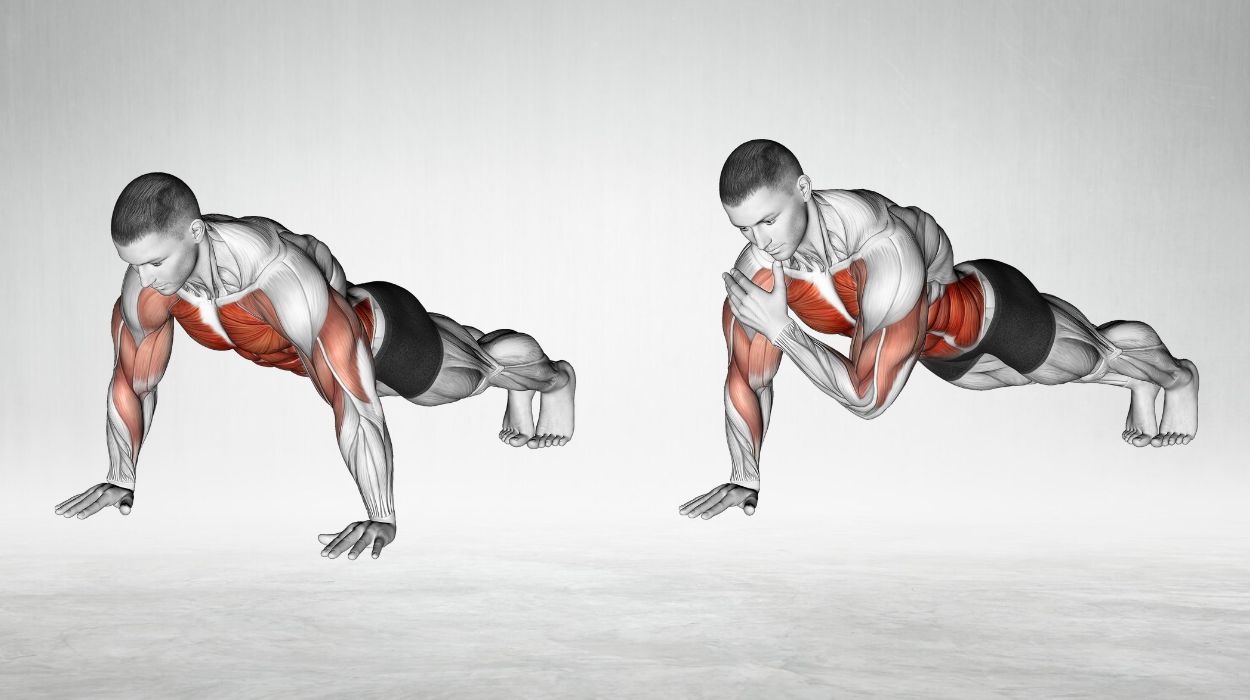
How to do:
- Find a mat and start in a plank position, keeping both hands planted firmly on the ground.
- While maintaining balance, lift one arm and tap your opposite shoulder with your hand.
- With control, place your hand back on the mat and repeat with the other arm.
Tips:
- Your hands should be shoulder-width apart.
- Engage your core and keep your back straight.
- Keep your hips aligned and avoid wobbling back and forth while performing the movement.
Optimal Sets and Reps:
- 3 sets.
- 10-12 reps.
Push Up

This is probably one of the most popular bodyweight exercises you can do for upper body strength. The primary muscle of the shoulder that is targeted is your anterior deltoid.[1] The two other active muscles include your triceps and pec muscles.
If you need to modify this exercise, you can always rest your knees on the ground for more stability. Follow the simple steps below when performing a push-up.
How to do:
- Start in a plank position with hands slightly wider than shoulder-width apart.
- Your hands should be firmly on the ground with your fingers facing forward or slightly outward.
- While in a push-up position, begin to lower your body while bending your elbows. Keep your elbows close to your torso at about a 45-degree angle.
- Lower your chest until it almost touches the ground.
- Press through the palms of your hands to bring you back to the starting push-up position. Repeat the exercise.
Tips:
- Your wrists should be aligned with your shoulder in the starting position.
- Keep your body straight from your head to your heels.
- Distribute the weight evenly between your palms and fingertips.
- Engage your belly muscles to avoid arching your lower back.
- Avoid locking your elbows when returning to the starting position.
Optimal Sets and Reps:
- 3 sets.
- 10-12 reps.
Inverted Rows
This lat pull-down alternative exercise targets multiple muscles of your upper body – think of it as a pull-up alternative. The main shoulder muscle targeted is your posterior deltoid.[2] Three other major muscles activated during this exercise include the biceps, lats, and lower traps.
Follow the steps below to get the most out of this no-weight shoulder workout.
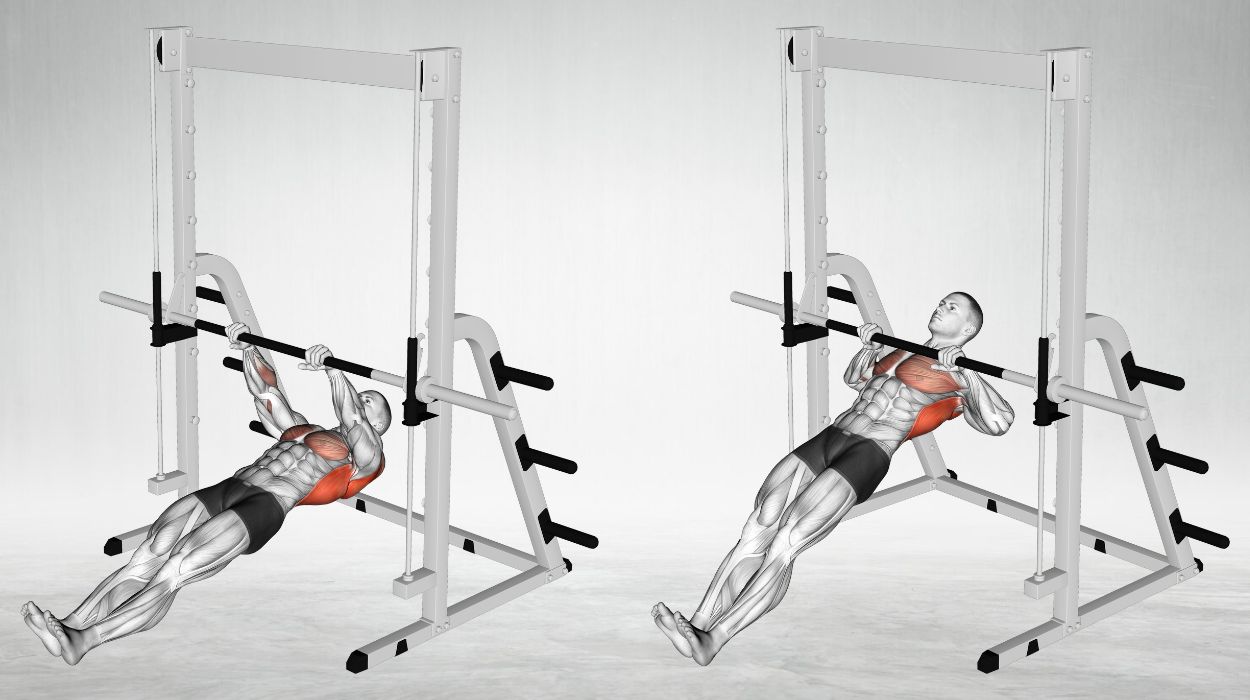
How to do:
- Begin by setting up a steady horizontal bar or suspension trainer at waist height.
- Lie on your back underneath the bar, gripping it with an overhand grip and hands shoulder-width apart.
- Extend your legs straight out in front of you, keeping a straight line from your head to your heels.
- Engage your core and glutes while keeping your body in a reverse plank position.
- Pull your chest towards the bar by retracting your shoulder blades.
- Gently lower your body back down to the starting position and repeat the exercise.
Tips:
- Keep your body straight, and don’t arch your back.
- When lifting your chest towards the bar, ensure your elbows face backward, not out to the sides.
- When lowering your body back to the starting position, maintain tension in your back muscles.
Optimal Sets and Reps:
- 3 sets.
- 10-12 reps.
Bear Crawls
This exercise might feel slightly awkward if you’ve never done it before. Don’t worry – this doesn’t mean you’re doing it wrong.
This dynamic exercise not only targets your shoulder muscles but also gets your core and leg muscles burning. Follow these simple steps below to try it out for yourself.
How to do:
- Begin in a tabletop position on your hands and knees. Your wrists should be aligned under your shoulders, and your knees below your hips.
- Lift your knees a few inches off the ground – this is your starting position.
- Crawl forward by taking small steps with your hands and feet simultaneously.
- Coordinate the movement so that your left hand and right foot move simultaneously and vice versa.
- Maintain the hover position as you move while keeping your hips steady.
Tips:
- Keep your core engaged and your back straight.
- Move in a controlled manner to maintain balance and coordination.
Optimal Sets and Reps:
- 3 sets.
- 10-12 reps.
Bench Tricep Dips
As the name implies, this exercise predominantly targets the tricep muscles in your arms. However, it also targets your anterior deltoid [3] and the pec muscles of your chest. Follow these simple steps below to get the most out of this workout.
How to do:
- Sit on a flat bench with your hands gripping the edge and fingers pointed forward.
- Place your feet flat on the ground, hip-width apart.
- With your hips off the bench, lower your body until your elbows are bent to about 90 degrees. Make sure to keep your back close to the bench.
- Push up through your palms until you return to the starting position. Repeat the exercise.
Tips:
- Keep your core engaged.
- Avoid shrugging by keeping your shoulders down.
- Make sure your elbows are pointed directly behind you – this targets your triceps more effectively.
- When you push yourself back up, avoid locking your elbows as you extend your arms.
Optimal Sets and Reps:
- 3 sets.
- 10-12 reps.
Handstand Hold
A handstand hold is a great way to practice improving your balance, strength, and coordination. If you’re a beginner, you can easily modify this exercise to fit your needs.
If you’re already a handstand expert, try challenging yourself with handstand push-ups instead. Check out these simple steps below to learn how to do a proper handstand hold.
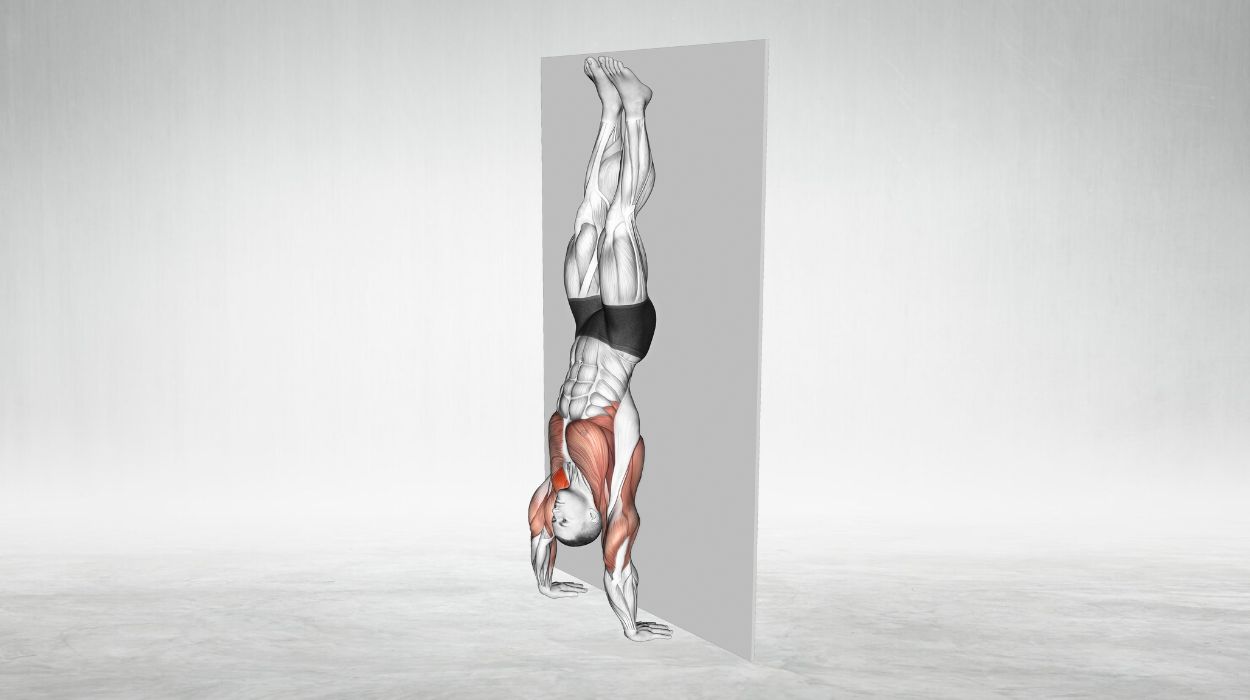
How to do:
- If you’re new to handstands, start by practicing against a wall. Begin in a kneeling position with your hands planted on the floor.
- Lift your hips and walk your feet closer to your hands – bring your body into an inverted V-shape.
- Shift your weight forward onto your hands while lifting one foot off the ground. Focus on bringing your hips over your shoulders.
- Move your weight forward and push off the back foot, bringing both legs up towards the ceiling.
- Try bringing your legs together to straighten them and focus on your balance. To come down, carefully bring one foot down at a time.
Tips:
- Your hands should be shoulder-width apart.
- Engage your shoulders by pressing them away from your ears with straight arms..
- Keep your toes pointed and engage your core to maintain balance.
- Focus on a spot on the floor to maintain balance.
Optimal Sets and Reps:
- Hold the handstand position for as long as possible.
- Start with short holds and increase over time as you gain strength.
Side Plank
This exercise targets multiple muscles at once, making it a great compound exercise to include in your workout routine. Your core, shoulders, hips, and leg muscles [4] activate when you hold a side plank position. To get the most out of this exercise, check out these easy steps below.
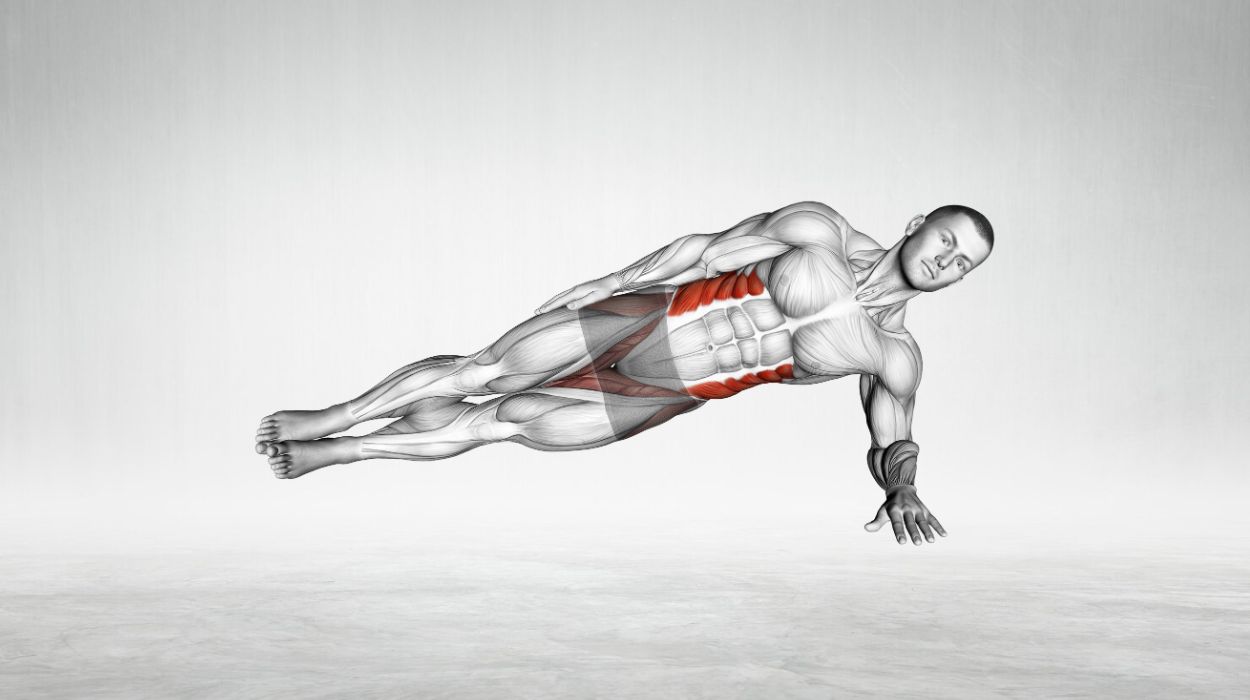
How to do:
- Lie on your side on a mat and prop your upper body up on your elbow. Make sure your elbow is directly beneath your shoulder.
- Stack your legs on top of each other, keeping your feet flexed.
- Engage your core and lift your hips off the mat, forming a straight line from your head to your heels.
- Hold the side plank position for the desired duration and then repeat on the other side.
Tips:
- When holding the position, your body should be supported by your elbow and the side of your bottom foot.
- Avoid letting your hips sag towards the ground.
- Focus on engaging your core.
Optimal Sets and Reps:
- If you’re a beginner, start with a short hold and gradually increase to longer durations as strength improves.
- Research has shown holding a side plank for 10 seconds [4] to be effective. Aim for this target when starting out.
Shoulder Muscles Anatomy
The shoulder is a complex joint that involves several muscles. These muscles work as a team to provide a wide range of motion – specifically for your upper body. Let’s take a closer look at these individual muscles.
Rotator Cuff Muscles
The main muscle group that supports the shoulder joint is the rotator cuff muscles.[5] Four muscles comprise your rotator cuff – supraspinatus, infraspinatus, teres minor, and subscapularis. These muscles help with the abduction (moving your arms away from the midline of your body) and rotation of the arm.
Deltoids
These large muscles give the rounded contour appearance of your outer shoulder. The deltoids are divided into three parts: anterior (front), medial (middle), and posterior deltoid muscle. (back). These muscles play an important role in arm abduction, flexion, and extension.
Trapezius
This large muscle spans across your upper back and neck. It assists in shoulder movement like elevating or retracting the shoulder blade. It also helps with the ability to extend and flex the neck.
Rhomboids
The rhomboids have two parts – minor and major. These muscles are located between your shoulder blades and are responsible for retracting and stabilizing your shoulder blades. Because of this, they contribute to posture and shoulder movement.
Pectoralis Major and Latisimus Dorsi
The pectoralis major – commonly called “pecs” – is a chest muscle. It plays an important role in shoulder flexion, adduction (moving your arms toward the midline of your body), and internal rotation.
In comparison, the latissimus dorsi are large muscles of the back. Commonly referred to as “lats,” these muscles assist in shoulder extension, adduction, and internal rotation.
Benefits Of Bodyweight Shoulder Workout
Exercise has long been known for its many health benefits. Exercise can help improve your health regardless of what area you’re targeting. Regarding body weight shoulder workouts, there are a few benefits to mention.
Improved Shoulder Strength
This may be one of the more obvious benefits, but it’s still worth emphasizing. Many people think you need to lift heavy weights or use other types of gym equipment to get stronger. However, resistance training has been shown to be very effective in helping people gain strength.[6]
Bodyweight resistance training involves using your own body weight as a force of resistance to improve strength. Additionally, it helps improve lean body mass by increasing muscle. This helps give your body a more lean and toned appearance.
Improved Posture
Studies have found that regularly engaging in upper body exercises – like those for your shoulder muscles – helps improve posture.[7] With the time many people spend sitting hunched over at a desk during work, shoulder exercises could help combat poor posture.
When your posture improves, your body is in its more natural form. This means your back and spine are straight. Improved posture is important for your spinal health, especially when it comes to preventing lower back pain.
Being physically active has been shown to decrease lower back pain [7] – one of adults’ most common health complaints. This can greatly effect your quality of life, making daily tasks seem difficult, let alone physical activity.
Flexibility
Without committing to a workout class or planning ahead of time, bodyweight exercises can give you flexibility. Being able to roll out a yoga mat or towel at home means you get to decide what time to workout. This keeps you accountable because you have no excuse not to get in a great workout.
This sort of flexibility may help save you time – you don’t need to travel back and forth just to exercise. This makes it a great option if you are running low on time or unable to leave the house as much as you’d like.
Adaptability
Bodyweight exercises are great for people of all fitness levels. This is because most of the exercises can be modified, and you don’t need to use weights for the exercises to be effective. This makes it a great option for beginners.
You can also easily switch up your workout routine, which can prevent you from getting bored while working out. This can help keep you motivated and focused on reaching your fitness goals.
Pro-tip: Work out with a friend so you can keep each other accountable. Being able to accomplish a challenging workout with a friend can make it feel more fun and exciting both of you.
Conclusion
Bodyweight exercises offer a variety of benefits to anyone trying to get healthier. We shared seven of the most popular shoulder exercises you can do without equipment with easy-to-follow steps. Following the steps, you’re on your way to a healthier lifestyle – not just strong shoulder muscles.
We also explained the anatomy of the shoulder muscles and their functions. The main shoulder muscles include the rotator cuff muscles and deltoids.
There are also a few other important muscles involved in shoulder movement. These include the trapezius, rhomboids, pectoralis major, and latissimus dorsi.
Upper body training can also help improve your posture [7] – something many people can relate to in today’s office work environments. Improved posture makes you less likely to suffer from lower back pain, which can negatively impact your quality of life.
Not having to drive to a gym can help save you time and money, making it a flexible option for many people. Whether you’re a beginner or a seasoned fitness guru, body weight exercises can be a great way to stay active.
Frequently Asked Questions
There is currently not enough evidence to support this claim. However, bodyweight resistance training has been shown to be very effective in helping people gain strength.
Focus on exercises that primarily target your shoulder muscles. For example, body-weight shoulder exercises like push-ups target the anterior deltoid muscles.
It depends. Like any form of exercise, results take time and consistency. On average, results of resistance training can be seen in around 8 weeks.
Yes, the muscles primarily targeted by doing push-ups are the anterior deltoids. These muscles are located on the front side of your shoulder.
Resources
- Borreani, S., Calatayud, J., Colado, J.C., Moya-Nájera, D., Triplett, N.T. and Martin, F. (2015). Muscle activation during push-ups performed under stable and unstable conditions. Journal of Exercise Science & Fitness, 13(2), pp.94–98. doi:https://doi.org/10.1016/j.jesf.2015.07.002.
- Youdas, J.W., Keith, J.M., Nonn, D.E., Squires, A.C. and Hollman, J.H. (2016). Activation of Spinal Stabilizers and Shoulder Complex Muscles During an Inverted Row Using a Portable Pull-up Device and Body Weight Resistance. Journal of Strength and Conditioning Research, 30(7), pp.1933–1941. doi:https://doi.org/10.1519/jsc.0000000000001210.
- McKenzie, A., Crowley-McHattan, Z., Meir, R., Whitting, J. and Volschenk, W. (2022). Bench, Bar, and Ring Dips: Do Kinematics and Muscle Activity Differ? International Journal of Environmental Research and Public Health, 19(20), p.13211. doi:https://doi.org/10.3390/ijerph192013211.
- Murofushi, K., Oshikawa, T., Akuzawa, H., Yamaguchi, D., Hirohata, K., Furuya, H., Mitomo, S., Kaneoka, K. and Yagishita, K. (2022). Trunk muscle activation in side plank exercises with and without external-focus instruction. Isokinetics and Exercise Science, pp.1–8. doi:https://doi.org/10.3233/ies-220016.
- McCausland, C., Sawyer, E., Eovaldi, B.J. and Varacallo, M. (2020). Anatomy, Shoulder and Upper Limb, Shoulder Muscles. [online] PubMed. Available at: https://www.ncbi.nlm.nih.gov/books/NBK534836/#:~:text=Muscles-.
- Lopez, P., Taaffe, D.R., Galvão, D.A., Newton, R.U., Nonemacher, E.R., Wendt, V.M., Bassanesi, R.N., Turella, D.J.P. and Rech, A. (2022). Resistance training effectiveness on body composition and body weight outcomes in individuals with overweight and obesity across the lifespan: A systematic review and meta‐analysis. Obesity Reviews, 23(5). doi:https://doi.org/10.1111/obr.13428.
- Kim, D., Cho, M., Park, Y. and Yang, Y. (2015). Effect of an exercise program for posture correction on musculoskeletal pain. Journal of Physical Therapy Science, [online] 27(6), pp.1791–1794. doi:https://doi.org/10.1589/jpts.27.1791.




